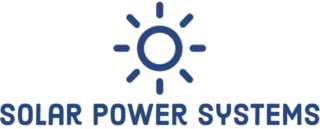Solar panels are just a part of the puzzle when it comes to solar energy. And indeed, this topic is becoming increasingly discussed with each passing month. Homeowners are eagerly seeking information on how to harness solar energy efficiently for electricity generation at home.
- According to the annual report by SolarPower Europe, in 2022, the world produced 239 GW of new solar energy. That’s a whopping 45% increase compared to the previous year.
Now, if you’re thinking that the decision-making process for your solar setup concludes with selecting the panels, you’re only halfway there. In addition to the panels, you’ll require a reliable charge controller and batteries.
Let’s delve into the importance of a solar power inverter, a crucial component that transforms the current to make it suitable for powering your home or business. Solar inverters come in various types, each offering unique features and advantages. Your decision can notably impact how efficiently and cost-effectively your solar power station operates.
As we go through this article, you’ll gain a better understanding of the various inverter types, empowering you to make the right choice for your solar energy needs.
What Is an Inverter for Solar Panels?
With each passing year, the demand for quality equipment for home solar systems, including solar inverters, is increasing. Based on estimates by Mordor Intelligence, these devices will make even more noise by 2029.

Solar inverters aren’t just obscure gadgets; they’re a vital component of any solar power station. They enable the harnessing of energy to power various devices and equipment. This is achieved through the vital function of the solar power inverter – converting direct current (DC) generated by solar panels into alternating current (AC). Why is this needed? To ensure that most industrial and household electrical appliances operate precisely due to alternating current.
The solar power inverter’s production of a clean sine wave output ensures it poses no hazard to different types of electronics Therefore, the device will not harm the internal configurations of devices or render them unusable.
Thus, solar inverters make solar energy available to power your home, business, or other facilities. Therefore, it can rightfully be called the “heart” of the solar system.
How Does a Solar Inverter for Home Work?
When discussing a typical inverter, like the one employed as a voltage converter in a car, it receives and delivers direct current from the device’s battery. A solar power inverter has one peculiarity: it receives the converted solar energy to power the solar panels for charging. Modern solar inverters are highly efficient, meaning they lose minimal energy during the conversion from DC to AC.
While the entire process takes only fractions of a second, let’s explore the details of what happens at each stage.
- Stage 1. Light Perception
Sunlight hits the photovoltaic cells in the solar panel and knocks electrons out of atoms. These free electrons generate an electric current, which is constant. The current-voltage depends on the amount of sunlight and the characteristics of the panels.
- Stage 2. Energy Conversion
The solar system inverter receives direct current from the panels and redirects it to the rectifier. From there, the current is fed into the inverter circuit, housing specific electronic components such as transistors. They convert the current to alternating current with a frequency and voltage corresponding to the parameters of your power grid. Pulse-width modulation is usually used to control the regulation of alternating current voltage.
- Stage 3. Synchronization
In the case of a grid-tied solar power inverter, it continually monitors the frequency and voltage of the grid, synchronizing with these parameters. Once synchronization occurs, the inverter can safely feed excess electricity into the grid.
- Stage 4. Battery Storage
Depending on the type of solar power inverter, the system may use batteries to store energy for later use. When there is excess energy, it is used to charge the batteries. If there is high demand for electricity or insufficient sunlight, the batteries can be used to power electric drives or the home.
Indeed, a solar power inverter is a complex yet essential device. The outlined stages provide a general principle of its operation, which can vary based on the type and model. When you know how solar inverters work, you will better understand how to use and maintain your solar system.
Main Types of Solar Panel Inverters
Selecting the appropriate solar power inverter might appear challenging, but fear not – we’ll guide you on what to pay attention to and consider.
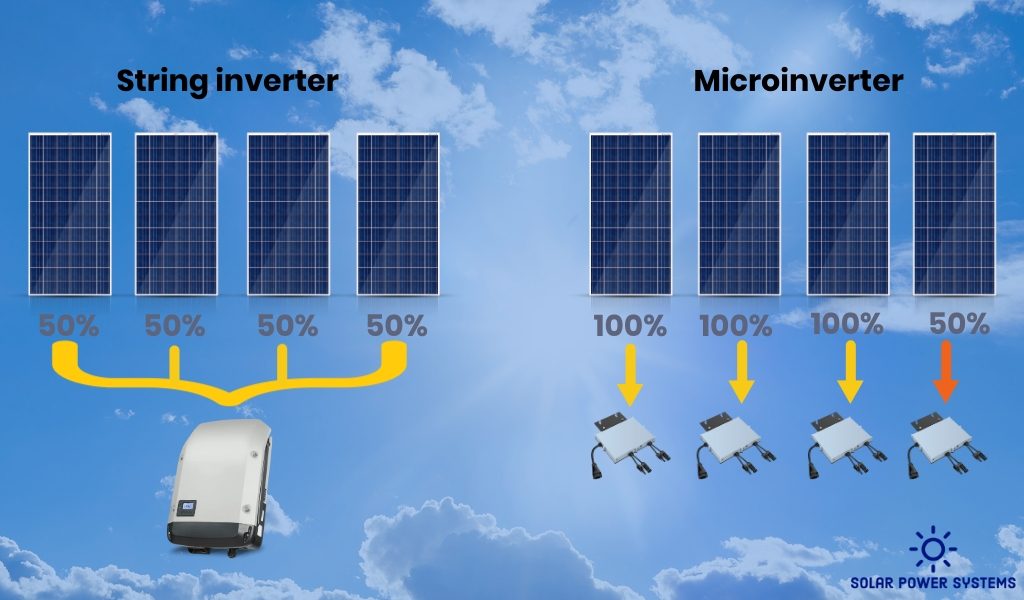
Centralized or String Solar Inverters
A string inverter is most commonly used in residential and small commercial solar energy systems. If you walk past a residential property and see a solar system on the roof or walls, we’re 99% sure it’s using a string inverter. Multiple solar inverters can be used for overly large or powerful systems merged into a single system.
Optimal placement involves a shaded area with convenient access to the solar system, particularly to the distribution box.
How Does a Solar Power Inverter Work?
It’s worth mentioning that a string inverter will suit you if the solar panels inside the entire system are connected not in parallel but in series. This way, the panels form a chain, and the device is connected to the end of this chain.
Features of String Inverters
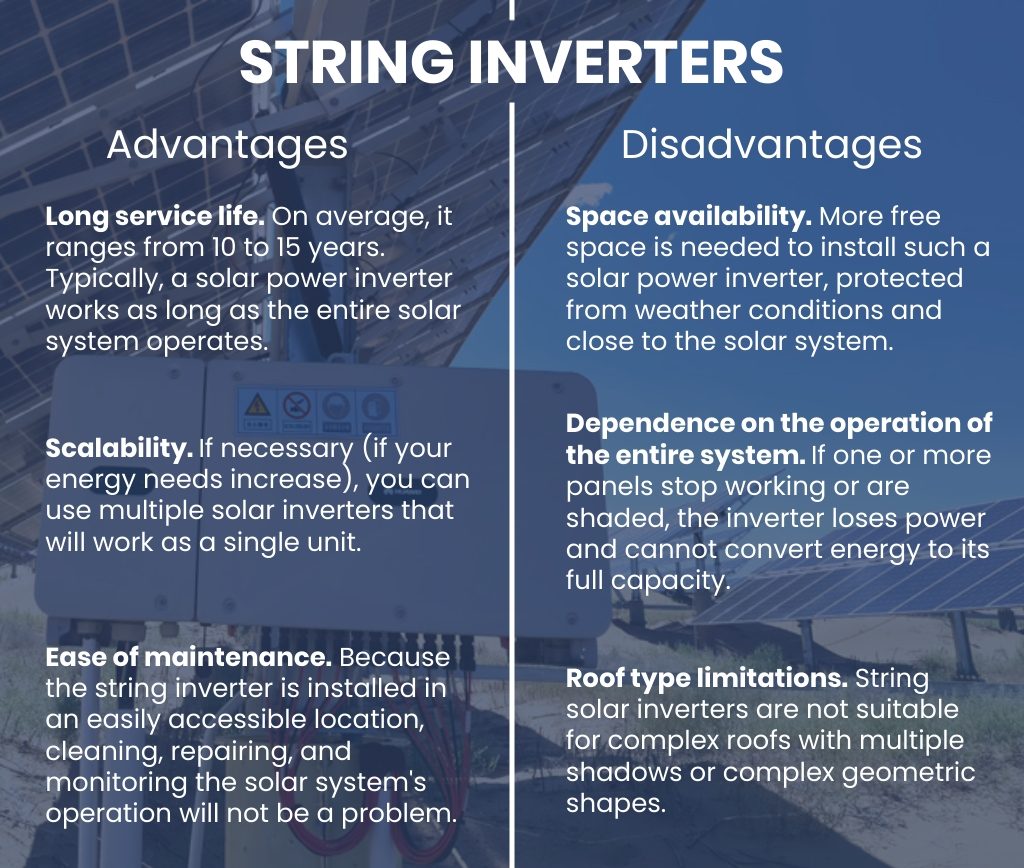
Micro Inverters
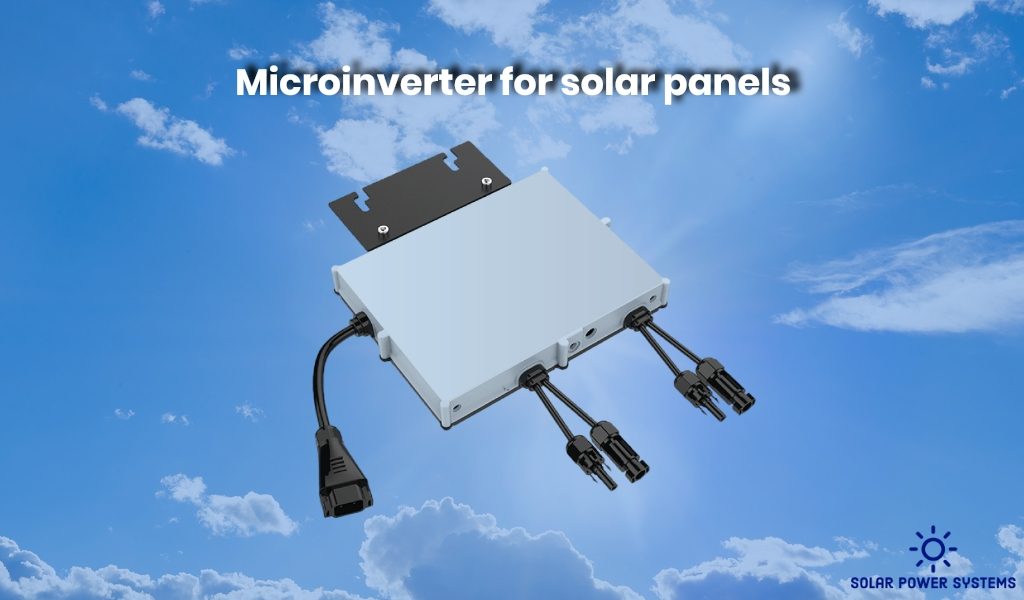
Micro inverters for solar panels, unlike string inverters, are installed separately for each of them from the backside. That is, each micro inverter operates independently at the location of the panel, separate from other solar inverters in the system. This means that solar panels continue to operate efficiently even if one does not produce as much electricity as the others. However, such devices typically cost more than traditional string solar inverters.
Being module-level power electronics (MLPE), they are considered a more technological and cooler option. According to encouraging forecasts from Future Market Insights, global demand for solar panels with micro inverters is expected to have a CAGR of 18.1% from 2022 to 2032. This growth is driven by several factors, including the increasing popularity of solar energy and awareness of the advantages of micro inverters.
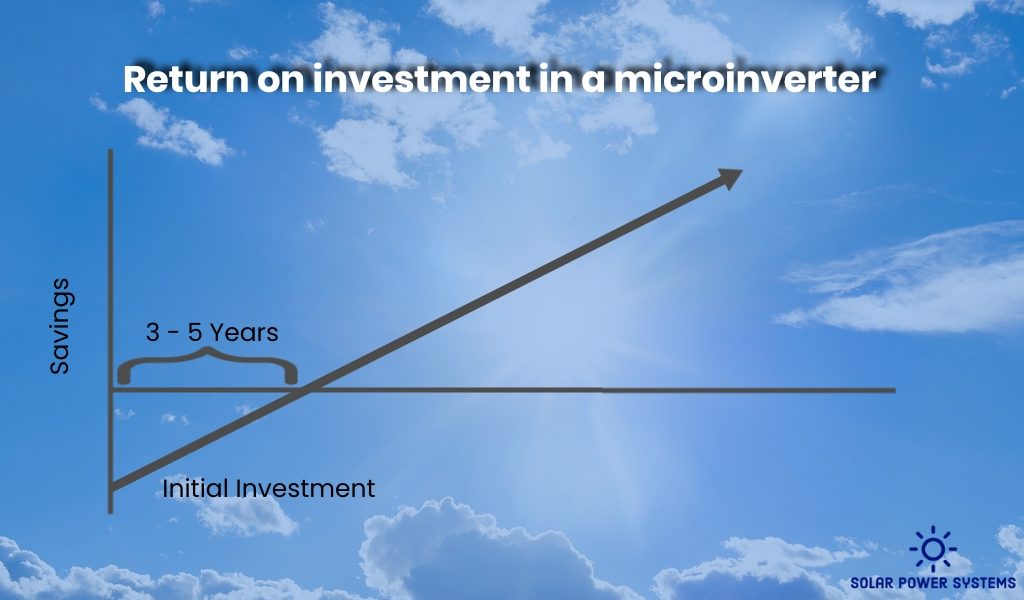
Key Features of Solar Panel Micro Inverters
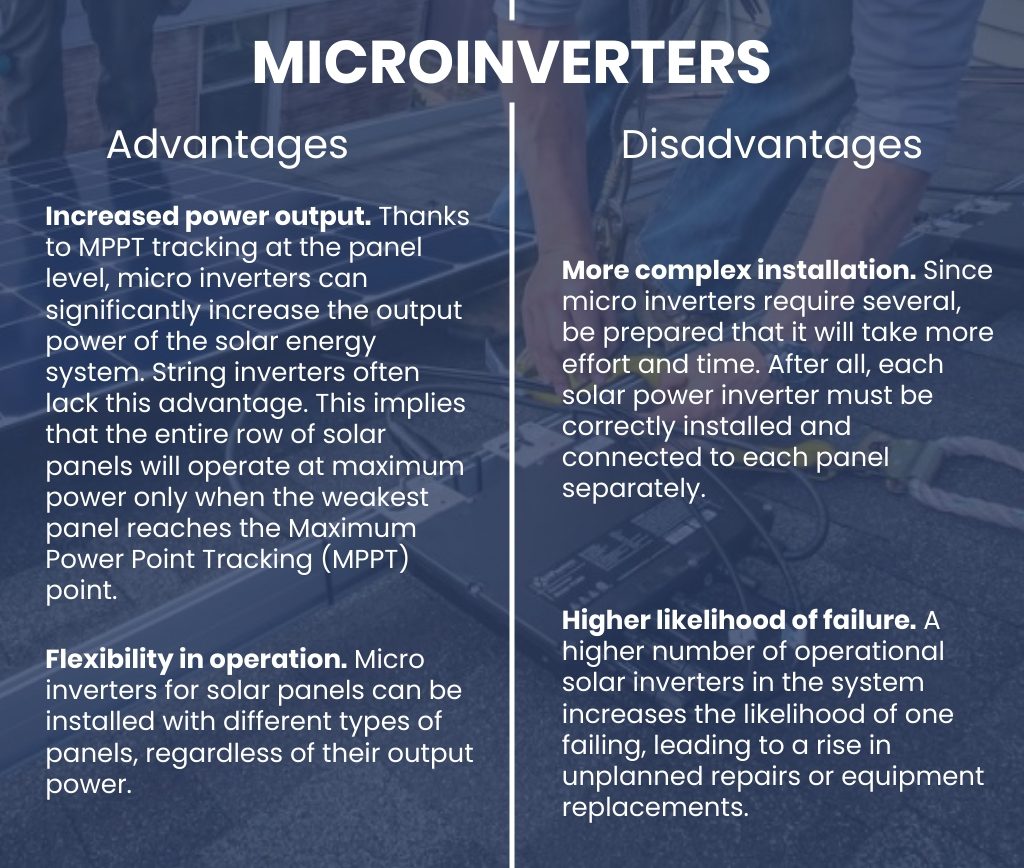
Central Solar Inverters
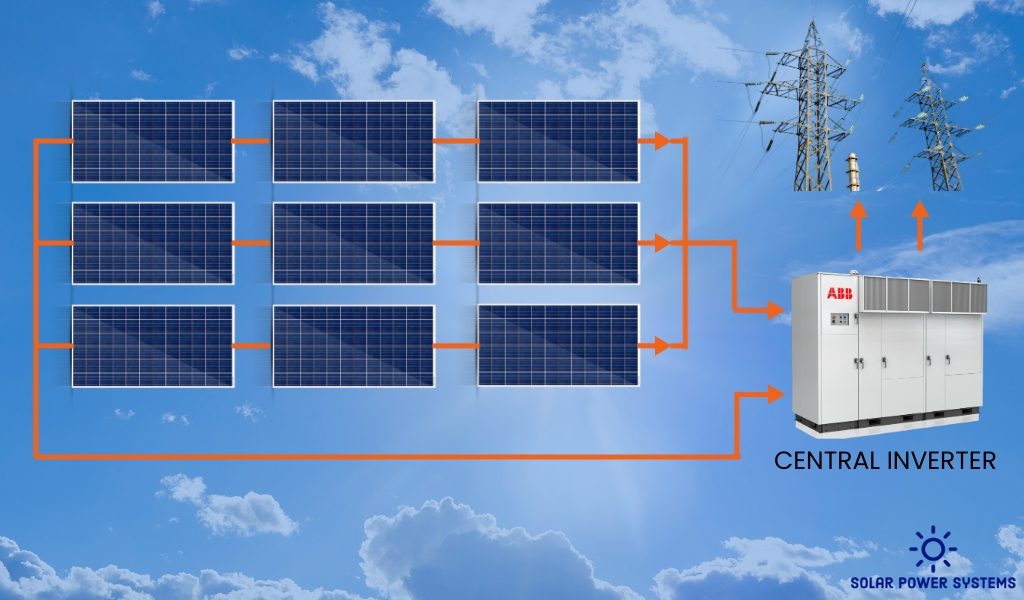
Central solar inverters are one of the three main types in the USA, alongside string inverters and micro inverters. They are known for their high efficiency and ability to handle large amounts of direct current generated by solar panels.
Since this device has a high capacity, it is typically used on a large commercial or municipal scale.
Features of Central Solar Inverters
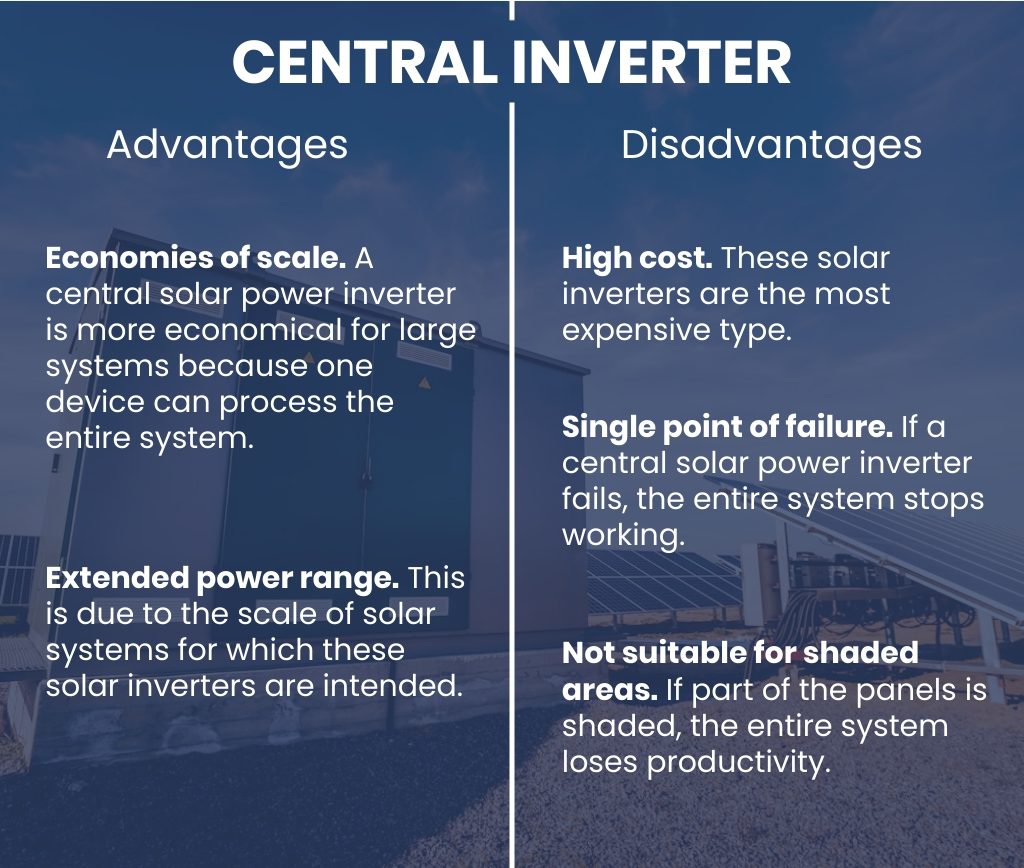
What to Consider When Choosing a Solar System Inverter
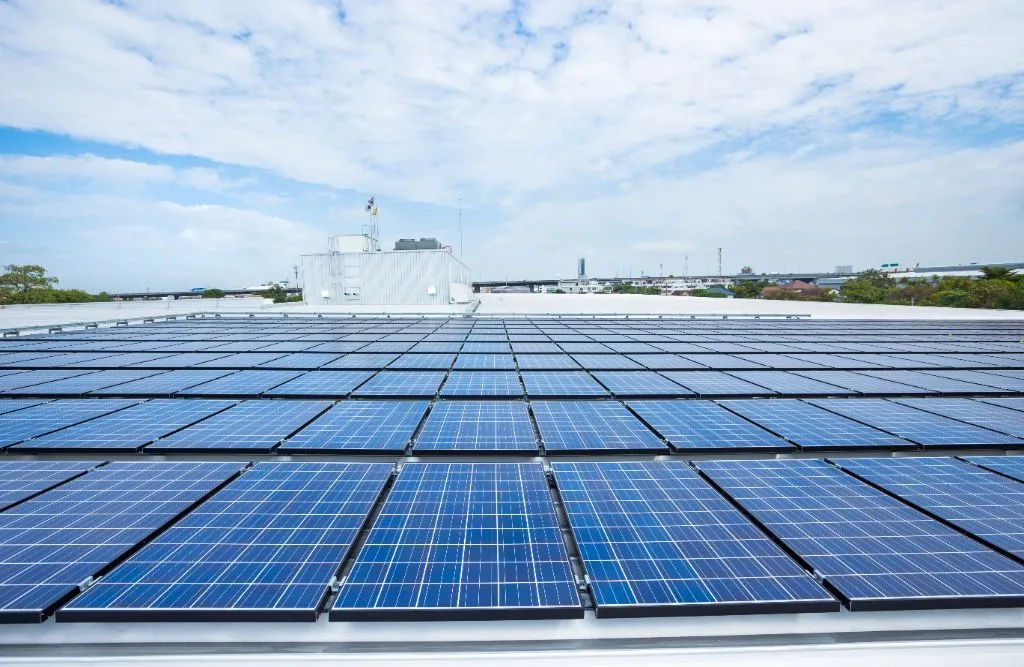
Selecting the right solar inverters affects many aspects of your solar power plant. So, before making a final decision, we recommend consulting with a qualified solar energy expert to ensure that the device fully meets your needs. Let’s discuss them further.
Inverter Efficiency
The efficiency of a solar power inverter is gauged by the ratio of the useful alternating current power it produces to the direct current power received from the panels. Therefore, selecting a solar power inverter with high efficiency allows you to maximize the use of energy generated by your solar panels. Low efficiency will result in the loss of a significant portion of the generated energy, which will negatively affect the economic viability of the power plant.
Micro inverters offer higher efficiency (on average, 1-3%) in energy conversion compared to a traditional string inverter. Choosing micro inverters isn’t always the clear-cut better option. It’s essential to weigh factors like price, installation simplicity, your electricity requirements and budget, temperature effects, inverter quality, and routine power loads to make an informed decision.
Functional Capabilities
In addition to the main function of converting direct current from solar panels into alternating current, modern solar inverters may have a range of additional features that make the power plant more convenient, economical, and safer.
Therefore, when choosing between different types of solar inverters, it is important to pay attention to the presence of features such as:
- Performance monitoring: It allows you to track electricity production at the moment, daily, weekly, monthly, or yearly. Knowing this, you can independently assess the system’s efficiency and make adjustments if necessary.
- Surge protection: Voltage spikes can undoubtedly harm household appliances. Therefore, a solar power inverter equipped with this feature will protect them, extending the lifespan of the solar system.
- Remote control: Monitor solar inverters’ operation from anywhere using a smartphone, tablet, or computer. You will be able to turn the device on and off or change settings remotely.
Price of Solar Inverters
A string inverter is relatively cheap. The average size of a solar system consisting of 10 panels will cost you between $630-1900. The price of micro inverters is usually 10-20% higher. This is partly due to the simpler installation of the former. It only requires connecting a single solar power inverter for the entire panel string and slightly lower efficiency due to the lack of optimization of each panel’s operation individually.
The cost of a solar power inverter can notably affect your budget. Yet, consider it as an investment in a quality device – a financially beneficial commitment for the future, ensuring guaranteed maximum returns from your solar power plant.
Keep in mind that prices for solar inverters often change and depend on the brand, functionality, power, and other factors.
Compatibility
Compatibility between solar system inverters and solar panels varies. It is crucial to verify and ensure that they are compatible for optimal performance. Unfortunately, this is often overlooked when choosing a device. Incompatibility leads to low system productivity, damage to existing equipment, and unstable operation with interruptions in the power supply. Then, you waste money and begin to doubt the decision to install a home solar power plant.
Avoiding unnecessary disappointments is simple. When buying solar panel inverters, consider:
- Technical specifications: The solar power inverter and panels should have the same rated voltage, input voltage range, and power.
- Type of solar inverters: Some solar inverter types are designed to work with specific types of panels – monocrystalline, polycrystalline, or others.
The Popularity of Different Types of Solar Inverters in the USA
Precedence Research statistics show that the market share of central solar inverters was 49.5% in 2022. Such a high figure is due to the attention of large enterprises that have decided to install solar inverters to meet the needs of their business.

Source: Precedence Research
For residential needs, homeowners frequently opt for string inverters. This is primarily attributed to their lower cost and simpler installation and maintenance systems.
At the same time, it is expected that the popularity of micro inverters will continue to grow due to:
- Increasing demand for smaller, more modular solar systems
- Increasing awareness of higher efficiency and better performance in shaded conditions
- Trends in cost reduction
Selecting the right solar power inverter depends on your specific needs and budget. Therefore, the popularity situation of certain inverter types may change every year or even month.
What Should You Consider When Choosing a Solar Power Inverter?
Choosing a solar system inverter is an important decision that can affect productivity, reliability, and cost. When picking solar inverters, consider the size of the solar installation, budget, energy needs of your family, specifics (level of shading, available space, roof type), and the nature of the service maintenance.
When seeking a suitable option for a residential solar system, explore choices between string solar inverters and micro inverters. Alternatively, for larger commercial needs, consider a central type of device.
Frequently Asked Questions
Is there a warranty for different types of solar inverters?
Yes, there is; however, warranty terms vary by type, manufacturer, and model. For example, Enphase, one of the leading manufacturers of micro inverters for solar panels, offers a limited warranty of up to 25 years.
How often does a solar power inverter need to be serviced?
It is recommended to perform comprehensive technical maintenance of solar inverters every 5 years. The frequency depends on the inverter types, operating conditions, and manufacturer. Therefore, regularly monitor the device’s condition and consult specialists if you notice any specific problems or deterioration in the functionality of the solar system.
What level of noise do solar inverters create?
The string inverter can produce slight noise during operation. Micro inverters are usually quieter.
What impact does the shading of panels have on the operation of a solar power inverter?
Shading can significantly reduce the productivity of string solar inverters. Micro inverters are more resilient because each panel is equipped with its own device.
